#argentinosaurus huinculensis
Explore tagged Tumblr posts
Text


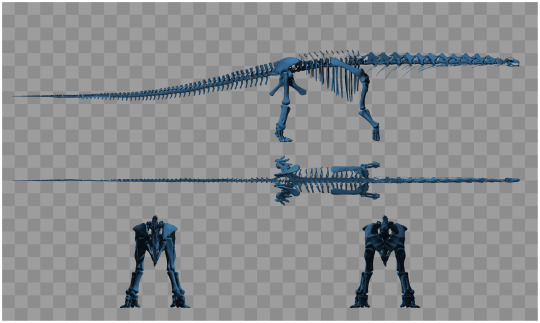




Argentinosaurus huinculensis
(temporal range: 96.2-92.19 mio. years ago)
[text from the Wikipedia article, see also link above]
Argentinosaurus is a genus of giant sauropod dinosaur that lived during the Late Cretaceous period in what is now Argentina. Although it is only known from fragmentary remains, Argentinosaurus is one of the largest known land animals of all time, perhaps the largest, measuring 30–35 metres (98–115 ft) long and weighing 65–80 tonnes (72–88 short tons). It was a member of Titanosauria, the dominant group of sauropods during the Cretaceous. It is widely regarded by many paleontologists as the biggest dinosaur ever, and perhaps lengthwise the longest animal ever, though both claims have no concrete evidence yet.
The first Argentinosaurus bone was discovered in 1987 by a farmer on his farm near the city of Plaza Huincul. A scientific excavation of the site led by the Argentine palaeontologist José Bonaparte was conducted in 1989, yielding several back vertebrae and parts of a sacrum—fused vertebrae between the back and tail vertebrae. Additional specimens include a complete femur (thigh bone) and the shaft of another. Argentinosaurus was named by Bonaparte and the Argentine palaeontologist Rodolfo Coria in 1993; the genus contains a single species, A. huinculensis. The generic name Argentinosaurus means "Argentine lizard", and the specific name huinculensis refers to its place of discovery, Plaza Huincul.
The fragmentary nature of Argentinosaurus remains makes their interpretation difficult. Arguments revolve around the position of the recovered vertebrae within the vertebral column and the presence of accessory articulations between the vertebrae that would have strengthened the spine. A computer model of the skeleton and muscles estimated this dinosaur had a maximum speed of 7 km/h (5 mph) with a pace, a gait where the fore and hind limb of the same side of the body move simultaneously. The fossils of Argentinosaurus were recovered from the Huincul Formation, which was deposited in the middle Cenomanian to early Turonian ages (about 96 to 92 million years ago) and contains a diverse dinosaur fauna including the giant theropod Mapusaurus.
7 notes
·
View notes
Text
Found some of my paleoart from few years ago.
Utahraptor ostrommaysi | probably oversized

Amargasaurus cazaui.

Eotyrannus lengi.

Speculative Dimetrodon (sp.?)

| Edit: I also found these two |
Argentinosaurus huinculensis

Stenonychosaurus inequalis

There's something in me that wants to get back at drawing things like these, but at the same time I feel like school at the time completely quenched that for me.. To just later on being unable to even finish my vocational due to being kicked out for reasons I can't do anything to. Like thanks a lot for fucking nothing ig...
And it pains me, since paleontology was such a large special interest for me, but I feel like I have regressed in it quite a lot. Idk.. if I ever have the motivation to, I definitely would love to get back at it.
76 notes
·
View notes
Text
Fossil Friday: Argentinosaurus

Argentinosaurus is a titanosaur from late Cretaceous Argentina. The animal is very fragmentary with only 14 known elements of which only two are complete.

So, how do we know it's the heaviest land animal to ever walk the earth? Well, we don't actually. We need more pieces of the puzzle before we can accurately answer that question. We can, at the very least, put in a clade though.
In a paper describing the holotype of Argentinosaurus, we can see the characters it possesses that place it within titanosauria:
"Argentinosaurus huinculensis is identified basically with Titanosauria, by the presence of diverse characters whose association is characteristic of this clade, and that have in part been already been pointed out and illustrated by Powell (1986): a) opisthocoelous dorsal vertebrae with relatively small, elliptic pleurocoels, located in the middle and anterior sector of the vertebral body, in a wide pleurocoelic depression of 8 oval form, more wide in the anterior sector than in the posterior; b) presence of very clear, angular fossae, in the lateral face of the neural arch of the dorsal vertebrae; c) neural spines of the anterior dorsals rather flat, wide transversely, and without vestiges of bifurcation; d) presence of large bony cells in the entirety of the spongy tissue of the dorsal and sacral vertebrae." (https://www.naturalhistory.si.edu/sites/default/files/media/translated_publications/Bonaparte%26amp%3BCoria_93.pdf)
Argentinosaurus was found in the Huincul Formation composed of green and yellow sandstones up to 820ft (250m) thick. It is thought to represent a drainage system of a braided river.

Plants known from this formation include hornworts, liverworts,


ferns, clubmosses,


gymnosperms (including gnetophytes like ephedra and conifers)


and angiosperms.

Animals found in this formation include lungfish, gar,


turtles, squamates,


sphenodonts, crocodiles,


and many dinosaurs including titanosaur Choconsaurus, rebbachisaurids Cathartesaurus and Limaysaurus, carcharodontosaurid Mapusaurus, abelisaurids Skorpiovenator, Ilokelsia, and Tralkasaurus, noasaurid Huinculsaurus and paravian Overoraptor.

Tune in on Monday to learn all about diplodocids in more detail. Fossilize you later!
#paleontology#fossils#dinosaur#sauropod#titanosaur#south america#argentina#argentinosaurus#huincul formation#paleoenvironment#paleobiology#science education#science
21 notes
·
View notes
Note
There's a meme going on about DA BIGGEST BIRD I'M DA BIGGEST BIRD but what WAS the biggest bird, anyway?
Argentinosaurus huinculensis
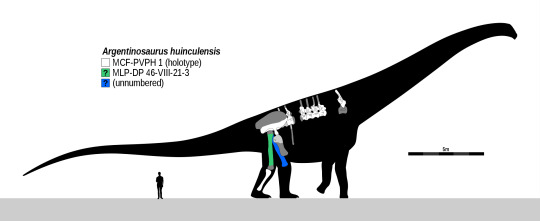
238 notes
·
View notes
Text
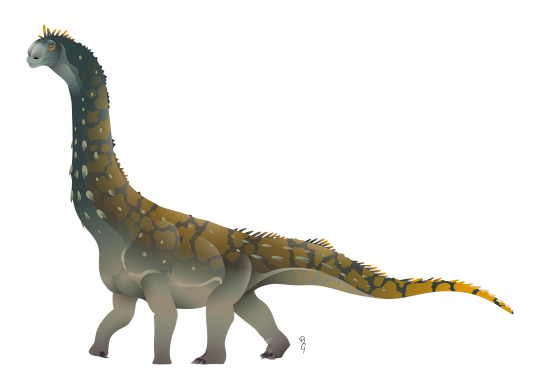
Argentinosaurus huinculensis
Reference: GunnarBivens skeletal (https://www.deviantart.com/gunnarbivens)
Vector illustration, 2023
#paleoart#illustration#cretaceous#dinosaur#vector#argentina#argentinosaurus#sauropod#sauropoda#titanosaur#titanosauria
30 notes
·
View notes
Text
Largest prokaryote: Thiomargarita magnifica, which can grow up to 1 cm (!!) in length, though tbh it's basically a micrometer-thick veneer of bacterium spread over a bag of inert water.
Largest unicellular organism with a single cell nucleus: the mushroom-shaped alga Acetabularia, which grows several cm tall.
Largest unicellular organism with multiple cell nuclei: the green alga Caulerpa taxifolia and the slime mold Physarum polycephalum can grow up to 30 cm, though in practice they function as multicellular organisms that lack membranes between a nucleus and another.
Largest animal: by linear size, the tendrils of the lion's mane jellyfish (Cyanea capillata) can reach 36 m long, and a specimen the ribbon worm Lineus longissimus was dubiously described as 55 m long. They are pretty thin, though. By mass, the highest non-controversial estimate for the largest non-fragmentary sauropod dinosaurs is around 80 tons (Argentinosaurus huinculensis), though there are dubious estimates from fragmentary remains pushing above 100 or even 200 tons. The known record for thee heaviest measured blue whale (Balaenoptera musculus) is 190 tons.
Largest non-colonial organism: the giant redwood General Sherman (Sequoiadendron giganteum) has been estimated to weigh almost 2000 tons, though the vast majority of that mass is probably dead wood tissue. The Lindsey Creek tree (Sequoia sempervirens) was estimated to weigh 3300 tons when it was felled by a storm in 1905. The tallest redwoods grow to 110-120 m tall, which is probably the physical limit for tree height on Earth.
Largest colonial organism: clonal colonies of trees and fungi can grow quite large indeed. The Pando aspen colony in Utah counts over 40,000 individual trees with ininterconnected roots, for an estimated total of over 6000 tons. A colony of the mushroom Armillaria ostoyae in Oregon covers 9 square km and may weigh over 30,000 tons. A colony of the seagrass Posidonia australis (an aquatic flowering plant, not an alga!) in Australia reportedly covers 200 square km, though I see no estimate of its mass. Apparently there is a supercolony of the ant Linepithema humile stretching between Spain, California, and Japan with "billions" of individual workers (assuming 0.5 mg per ant, that would still mean only a few tons of total mass).
11 notes
·
View notes
Note
hiii! did yuo know that argentina is one of the most important countries in terms of dinosaur paleontology, with a total of 170 valid dinosaur species as well as the largest known dinosaur (Argentinosaurus huinculensis) and some of the earliest known dinosaurs (e.g. Eoraptor lunensis, Eocursor parvus)? (i saw that you were mutuals with one of mine so i thought i would say hi :3)
hi!! :3
yeah i knew about the argentinosaurus :3
its my fav dinosaur!! :3
but i didnt know about all the others!! :3
very interesting, tysm!! :3
2 notes
·
View notes
Text
Random Dino Fact #3
The title of largest known dinosaur currently belongs to Argentinosaurus Huinculensis, a titanosaur that lived about 94 million years ago in the Late Cretaceous.

At an upper estimate of 80 tonnes in weight and 35 metres in length, this absolute behemoth is not only the biggest dinosaur but the largest land animal ever to walk the earth. For context, the infamous Tyrannosaurus Rex weighed in at a comparatively minuscule 8.87 tonnes with a length of 12.4 metres.
Somehow though, this still wasn’t big enough to prevent predators from taking them down; there is evidence that they were hunted by equally massive predators such as Mapusaurus and Skorpiovenator, though most deaths from hunting were during adolescence or old age as an adult Argentinosaurus would have been almost completely impervious to attack from pretty much anything due to its sheer size.
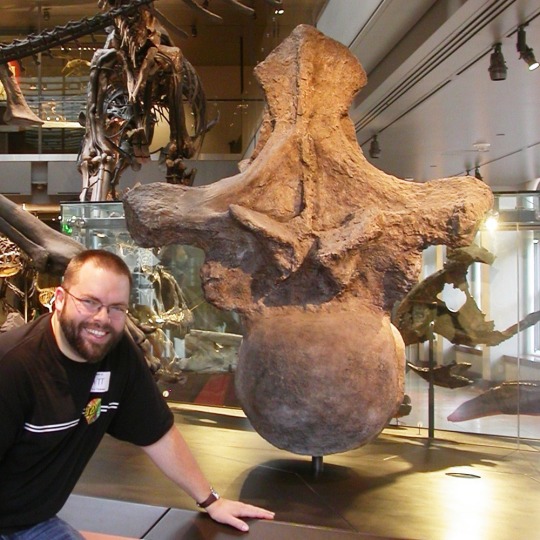
As always, size has its drawbacks, and the weight of this guy meant it could only move at a top speed of 5 miles per hour, slightly faster than the average human walk. On top of that, it would have had to eat AT MINIMUM 517 kg (1,139.79 lbs) of plant matter EVERY DAY, not even considering the fact that it would have to move around to get access to that much food.
There is currently a debate within the scientific community about whether A. Huinculensis is truly the largest, as Dreadnoughtus, Paralititan, Puertasaurus, Alamosaurus, Patagotitan, Futalognkosaurus, Maraapunisaurus and Antarctosaurus have all at separate times have been considered to be slightly bigger or smaller based on different studies at different times.
1 note
·
View note
Note
"Argentinosaurus Huinculensis"
Fuente: masneuquen.com
Ilustrador: Agustín Ozan
no entiendo nada de lo que está pasando pero te dejo emojis de dinosaurios <3
🦖 🦕
gracias 💕 te dejo un dibujito de argentinosaurus q encontré en internet (re chorra si alguien tiene el crédito se agradece creo que es de un libro igual)

9 notes
·
View notes
Link
Size comparison of some of the largest animals that ever lived.
#tyrannosaurus rex#Purussaurus Brasiliensis#spinosaurus aegyptiacus#aepyornis maximus#titanoboa cerrejonensis#archelon ischyros#paraceratherium transouralicum#palaeoloxodon namadicus#parapuzosia seppenradensis#leedsichthys problematicus#otodus megalodon#shastasaurus sikanniensis#argentinosaurus huinculensis#blue whale#largest animals#size comparison
2 notes
·
View notes
Text
Pie Pequeño: Argentinosaurus huinculensis
Cera: *ERROR SOUTH AMERICAN CERATOPSIANS NOT FOUND*
Ducky: Kelumapusaura machi
Petrie: Argentinadraco barrealensis
Spike: Jakapil kaniukura
Mordelón: Giganotosaurus carolinii
#podría reemplazar a cera por alguno de esos estegosaúridos raros que nadie conoce como Isaberrysaura#cosas mias#land before time
49 notes
·
View notes
Text
Modern elephants weigh about 5 tons and produce about 20lbs of dung per defecation
Argentinosaurus huinculensis, the biggest land animal ever, weighed about 100 tons on the high end. As herbivores, their feces were probably the same consistency as elephants. Therefore we can assume almost the same mass, so a 100 ton Argentinosaurus could produce roughly 400lbs/181kg of feces in one defecation. Let’s say the average saruopod’s anus is about 4m off the ground (comparing with this 2m/6ft human)
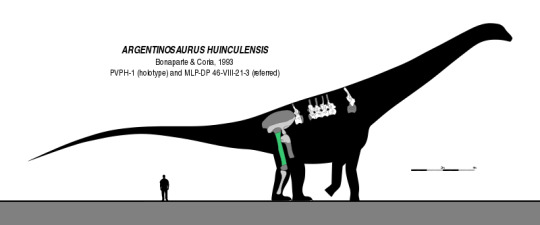
Ignoring air resistance and any pushing by the animal, it would take the poop about a second to hit the ground and it would hit the ground at 8.85 m/s or 31.88 km/h. This is about 1601.85N of force. It takes about 3000N to break a human neck. So even if you were to lay flat on the ground, the crushing force of the falling dino-rhea wouldn’t be enough to kill you, but it would be quite painful. However, you’re now covered in a 400lbs pile of shit and you will probably suffocate and die. Thanks for coming to my TED talk
#unhygenic tw#paleobiology#paleontology#please this isnt meant to be serious at all this was a compilation of a discord disscussion the math was done in like three minutes#dinosaur#argentinosaurus#palaeoblr#paleoblr
9K notes
·
View notes
Photo

Argentinosaurio huinculensis
Argentinosaurus huinculensis es la única especie conocida del género extinto Argentinosaurus de dinosauriosaurópodo titanosauriano que vivió a mediados del período Cretácico, entre hace 97 y 93,5 millones de años, en lo que hoy es América del Sur.
Suborden: Sauropodomorpha
Familia: Andesauridae Descripción:
Es uno de los animales terrestres más grandes de los que se tiene conocimiento actualmente. Pero los restos conocidos son escasos, por lo que no se puede estimar de manera precisa sus dimensiones corporales. De entre las diferentes estimaciones propuestas, el promedio sería de 33 metros de longitud y 73 toneladas de peso. Era un dinosuario herbívoro.
3 notes
·
View notes
Video
So that’s no longer a completely true fact depending on your measure of size. Rorqual whales are the most massive of animals we know to have existed, but other groups may be larger in other dimensions.
It’s first worth noting that most blue whales do not reach the maximum reliably recorded size of 30 metres, with populations usually averaging below 25, most often between 21-24 metres. These kinds of sizes mean that some extinct marine reptiles may be comparable, with the largest reliable estimates for Triassic ichthyosaurs within the family Shastasauridae coming in at around 21 metres in length (and comparable in mass to a whale of similar size).
Although aquatic animals like rorqual whales and these giant ichthyosaurs can be much heavier, upper length estimates for several terrestrial sauropod dinosaurs (particularly a few genera whithin the Cretaceous group Titanosauria but also a couple of diplodocoids from earlier in the Jurassic) are longer than 30 metres by a significant margin. These animals’ remains are often quite incomplete so length estimates can have wide margins of error; the most completely known of these, Dreadnoughtus schrani, is ~70% complete and estimated at around 26 metres in length. Less completely known, but larger titanosaurs (Patagotitan mayorum, Argentinosaurus huinculensis) have been given size estimates between 30-40 metres - although conservative estimates closer to the lower bound are likely more accurate. Gregory S. Paul found the latter of these two to be the largest, coming in at 35 metres. Diplodocoids where much less robust and therefore lighter than the later-living titanosaurs, but species like Supersaurus vivianae probably also attained sizes of 33-34 metres.
262K notes
·
View notes
Text
i got tagged by @jessinthesky so hEre wE gO
Nickname: Nic (@ anyone who doesnt know, dont call me by my old name o o f)
Gender: idk anymore, whatever you want man
Star sign: Leo
Height: i think its around 5′4″ but i havent checked in awhile
Sexuality: Asexual, Biromantic
Favorite Band: Muse
Favorite Solo Artist: i havent listened to any solo artists in awhile so i guess Gerard Way?
Song stuck in my head: Vertigo Cave by The Used
Last movie i’ve seen: Thor Ragnarok
Movies I want to see: I really want to watch Brother Where Art Thou again
Last TV show i watched: I don’t watch TV usually but it was probably something from the science channel
When did you create your blog: Just this year! still a baby blog
What do you post/reblog: ugh i dont know anymore its all over the place im sorry
Last thing you googled: Argentinosaurus Huinculensis. dont ask
Other blogs: none. hence why my blog is so weird
Why url: It’s a lyric from a song called Netflix Trip by AJR, made me cry a few weeks ago so it earned a place on my blog
I follow: 285
Followers: only 22 oh god
Average hours of sleep: usually 12, sometimes 1
Lucky number: 2
Instruments: nothing, but i can sing pretty damn well
What are you wearing: basic grey T-shirt and some sweatpants
Dream Job: Musician, the usual
Dream trip: New Zealand
Favorite food: sushi
Top 3 universes: the ones where i’m not a goddamn idiot and can actually do shit
Last book I read: Of Mice And Men (still reading it)
Uh i guess i’ll tag @anthropormorphiccarrot @mularkee @cakesoup and whoever wants to do it! i know close to no one so just like. have fun with it
#i knew the day would come where i get tagged in this#i saw it going around the libs fandom and thought#'oh god it'll come to me eventually'
5 notes
·
View notes
Photo

Argentinosaurus Huinculensis and me as scale 👉 Museo Municipal Carmen Funes de Plaza Huincul, Neuquén, Argentina. . 🦕 Argentinosaurus Huinculensis (right) and Giganotosaurus Carolinii (left), the world's largest dinosaurs discovered so far. 🦕 El Argentinosaurus Huinculensis (derecha) y el Giganotosaurus Carolinii (izquierda), los dinosaurios más grandes del mundo descubiertos hasta ahora. . 👉 Check out my last post for more!. . 👣TBT from my geological journeys to the Patagonia!. . #neuquen #ruta40 #patagoniaargentina #paisajesargentinos #surargentino #dinosaurios #patagonia #argentina_ig #vivaargentina #argentina_en_fotos #dinosaurs #dinosaurio #landscapelover #hike #senderismo #andesmountains #paisajenatural #fotografiadepaisaje #fotografiando #geologyrocks #geologistlife #exploretheworld #beautifulplaces #cordilleradelosandes #geologist #geologo #geologia #lindosmomentos #superandoteatimismo . (en Museo Carmen Funes) https://www.instagram.com/p/B5bk2DOFpUw/?igshid=1a83z20bp9hx8
#neuquen#ruta40#patagoniaargentina#paisajesargentinos#surargentino#dinosaurios#patagonia#argentina_ig#vivaargentina#argentina_en_fotos#dinosaurs#dinosaurio#landscapelover#hike#senderismo#andesmountains#paisajenatural#fotografiadepaisaje#fotografiando#geologyrocks#geologistlife#exploretheworld#beautifulplaces#cordilleradelosandes#geologist#geologo#geologia#lindosmomentos#superandoteatimismo
0 notes